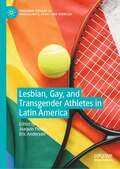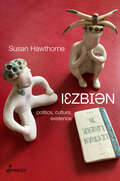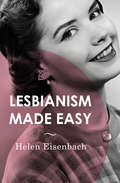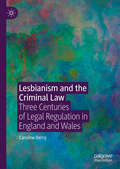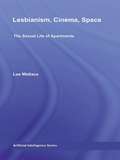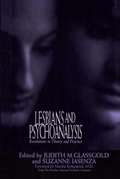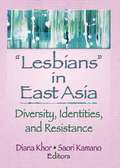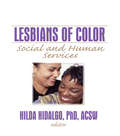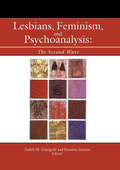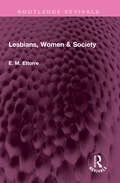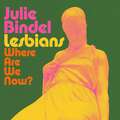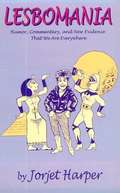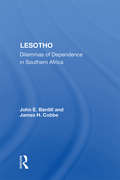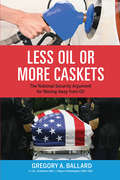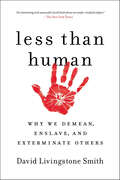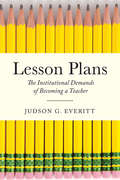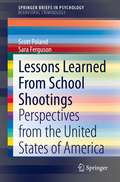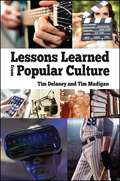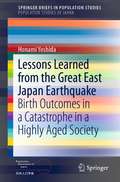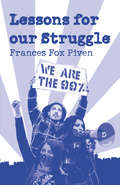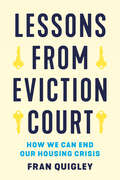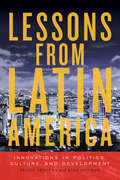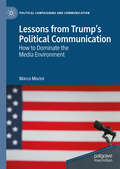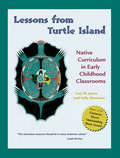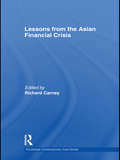- Table View
- List View
Lesbian, Gay, and Transgender Athletes in Latin America (Palgrave Studies in Masculinity, Sport and Exercise)
by Eric Anderson Joaquín PiedraThis edited volume draws upon work from a wide range of established and emerging international scholars to provide an interdisciplinary analysis of sport’s complex relationship with masculinity. With a particular focus on Latin America, it examines the changing relationship between a range of contemporary sport and sexuality and gender expression, as related to lesbian, gay and/or trans athletes. Experts from Spain, Argentina, Brazil, Mexico, and Colombia provide historical, sociological and anthropological perspectives on heteronormativity, masculinity, gender identity, sexual orientation, and the gender binary as they relate to sports clubs, Mexican martial arts, football, softball, sports media, games, and physical education. It will be invaluable to scholars and students in the fields of Gender Studies, Queer Studies, Sports Studies, and Men’s Studies.
Lesbian: Politics, Culture, Existence
by Susan HawthorneAcross almost 50 years of writing, Susan Hawthorne' s essays on lesbian culture and politics take the reader on a journey through the concerns of radical feminists engaged in the Women' s Liberation Movement. Not only does she trace the experiments of lesbians creating a vibrant woman-loving culture, but she also traces the backlash against lesbians and a history of violence perpetrated by the state, corporations and individual men. She begins with a recollection of a rape in her pre-feminist days, followed by a critique of the institution of heterosexuality and the role of lesbian feminism as a strategy. She is soon asking questions about lesbian existence. The essays span reflections on lesbian literature and the development of lesbian culture, including the politics of physical expression in circus. Susan Hawthorne writes about cultural appropriation, depoliticization and the erasure of lesbian inventiveness. She researches violence against lesbians including rape, torture and murder and the way in which this violence is ignored and often distorted by the media. Her investigations include lesbian refugees, lesbian economics, violation of lesbian human rights and the impact of the transgender industrial complex on the existence of lesbians as a political force.
Lesbianism Made Easy
by Helen EisenbachThe essential guide to enjoying modern lesbianism These days, lesbians are everywhere you turn, streaming for your entertainment or commenting on the important political movements and hairdos of the day. Yet as more doors open on this often-misunderstood world, who hasn&’t found him- or herself wondering how he or she might uncover the secrets, experience the glamour, enjoy the special advantages of lesbianism? Helen Eisenbach&’s hilariously irreverent guide provides a front-row seat to a largely female universe where love, lust, and forbidden laughter are just a fingertip away. Sharing hard-earned truths with sly insight and wit, Eisenbach reveals the fascinating inside story of a growing culture and shows how anyone can acquire the skills and state of mind to be a lesbian. From flirting to family values, from work to play, from enlightening friends, relatives, or strangers to figuring out how to have sex with women or choose a pet, Lesbianism Made Easy answers all your questions—and some you didn&’t know you had.
Lesbianism and the Criminal Law: Three Centuries of Legal Regulation in England and Wales
by Caroline DerryThis book offers a comprehensive examination of the ways in which the criminal justice system of England and Wales has regulated, and failed or refused to regulate, lesbianism. It identifies the overarching approach as one of silencing: lesbianism has not only been ignored or regarded as unimaginable, but was deliberately excluded from legal discourses. A series of case studies ranging from 1746 to 2013 from parliamentary debates to individual prosecutions shed light on the complex process of regulation through silencing. They illuminate its evolution over three centuries and explore when and why it has been breached. The answers Derry uncovers can be fully understood only in the context of surrounding social and legal developments which are also considered. Lesbianism and the Criminal Law makes an important contribution to the growing bodies of literature on feminism, sexuality and the law and the legal history of sexual offences.
Lesbianism, Cinema, Space: The Sexual Life of Apartments (Routledge Advances in Film Studies)
by Lee WallaceIn this cutting edge volume, Wallace identifies a unique trend in post-Production Code films that deal with lesbian content: stories of lesbianism invariably engage with an apartment setting, a spatial motif not typically associated with lesbian history or cultural representation. Through the formal analysis of five lesbian apartment films, Wallace demonstrates how the standard repertoire of visual techniques and spatial devices (the elements of mise-en-scène, favoured locations and sets, classical systems of editing, and the implied story world itself) are used to scaffold female sexual visibility. With its sustained focus on the filmic syntax surrounding lesbian representation on screen in the post-Production Code era, the book comprises an original contribution to queer film studies. In addition, Wallace also deploys its discussion of lesbianism and cinematic space to critique a number of tendencies in contemporary social theory, particularly the theoretical identification of public sex cultures as the basis for a queer counterpublic sphere.
Lesbians and Psychoanalysis: Revolutions in Theory and Practice
by Judith M. Glassgold Suzanne IasenzaPsychoanalytic theories of lesbian development epitomize the difficulty in liberating psychoanalysis from the past. Psychoanalytic theory has traditionally adopted a clear position that a lesbian orientation represented some form of psychological abnormality. Thankfully-- but only very recently-- some influential feminist leaders have begun to rethink issues of gender and sexual orientation, removing heterosexuality from its privileged position as normal. In "Lesbians and Psychoanalysis", Judith M. Glassgold and Suzanne Iasenza bring together twenty-six of these pioneers in the field of lesbian psychoanalytic theory. Through insightful chapters based on years of clinical experience, each author helps to redefine psychoanalytic theory by reinventing its foundations from an affirmative perspective so that it better represents all peoples. "Lesbians and Psychoanalysis" addresses several topics of emerging concern including multicultural diversity, self-disclosure, homophobia, transference/countertransference issues, bisexuality, and the changing nature of lesbian sexuality. In addition, the authors examine the influence of stigma on human development. In three sections-- Past, Present, and Future-- the authors in turn critique past theory, discuss current issues in therapy, and describe new directions in theory and practice. This is a book that is sure to appeal not only to members of the psychoanalytic community but also to all those who are interested in gay and lesbian studies, feminism, and psychology.
Lesbians in East Asia: Diversity, Identities, and Resistance
by Julie Garrison ADiscover the courageous, vibrant similarities and differences of lesbians in East AsiaHow are same-sex relationships similar or different in the cultures of East Asia? "Lesbians" in East Asia: Diversity, Identities, and Resistance is a unique examination of research and vital issues involving lesbians and lesbianism in East Asia, using perspectives by academics and activists who typically are rarely published in English. Contributing experts from Hong Kong, mainland China, Japan, and Korea discuss a variety of topics, including solidarity and conflicts between lesbians and feminists, identities and identity politics, lesbian lives and families, and representation in mainstream culture.Asia, because of its inherent language and cultural differences from Western society, is a location of a vast unrealized fount of knowledge about same-sex relationships and the societies in which they interact. "Lesbians" in East Asia: Diversity, Identities, and Resistance begins to fill this gap in knowledge, going beyond "East-West" divisions by gathering in one volume studies in Asia lesbian/queer studies of both the West and Asia. The text&’s emphasis is on points of connection and cooperation across the cultures within Asia and between this region and other areas of the world. Diverse viewpoints and research on lesbians in China, Hong Kong, South Korea, and Japan are presented showing issues and concerns that may be different-and often are very similar-to regions beyond those borders.Topics in "Lesbians" in East Asia: Diversity, Identities, and Resistance include: lesbian rights and feminism in Korea emotional damage suffered in family, work, and school contexts, including self-denial analysis of Internet exchanges in China, highlighting those feeling that they should maintain a low profile and others showing disdain toward the lesbian lifestyle gender inequality and discrimination and their effects on self-sufficiency the effects of expectations of marriage or remaining single on economics, legal standpoints, and in school ignorance and intolerance in Korean and Japanese societiesidentity politics conflicts of ideas between lesbians and feminists and much more! "Lesbians" in East Asia: Diversity, Identities, and Resistance is important, illuminating reading for academics and students in women&’s studies, gender studies, queer/sexuality studies, East Asian studies, and activists in feminist movements.
Lesbians of Color: Social and Human Services
by Hilda HidalgoBroaden your understanding of lesbians of color, their perspectives, and their needs from a human services point of view. Lesbians of Color: Social and Human Services helps you understand the ways in which lesbians of color perceive important issues related to their oppression and discrimination by the dominant social service community. The authors’personalized accounts graphically depict the deep-seated impacts of society’s racism, sexism, and homophobia. This insightful book suggests effective ways of changing detrimental practices and agency policies that perpetuate oppression and discrimination, and it enhances your interactions with lesbians of color. Chapters build on “feminist standpoint theory,” a theory of inquiry enlightened by authors’firsthand knowledge that helps you move from an intellectual to an empathic grasp of the points made by each author. The use of standpoint theory gives you a different way of gaining insight and understanding of the experiences of lesbians of color. It acts as a springboard for valuing and celebrating the experiences and perspectives of lesbians of color so you can, in turn, provide more sensitive and effective services to members of this population. Among the topics explored in Lesbians of Color are: specific ways white practitioners should behave to demonstrate their sensitivity and respect for lesbians of color insight as to how “need perceptions” and “problem diagnosis” varies when the practitioner listens to and understands lesbians of color specific identity issues that affect the emotional well-being of adopted lesbians visibility and activism as contributors to the mental health of lesbians of color how visibility and activism are essential in creating positive changes in policies and practices for lesbians of colorThis volume is useful for professionals involved in direct service practice with lesbian clients and for administrators of social service agencies. The book is also a helpful guide for educators in professional preparation programs who must introduce students to issues related to lesbians of color.
Lesbians, Feminism, and Psychoanalysis: The Second Wave
by Suzanne Iasenza Judith GlassgoldGet a feminist perspective on important changes in psychoanalysis! Lesbians, Feminism, and Psychoanalysis: The Second Wave examines recent changes in psychoanalysis that have opened the door for new perspectives on same-sex desire. Authors from a variety of disciplines and theoretical orientations combine feminism with psychoanalytic and postmodern theories to celebrate diversity in gender and sexual experience. This collection of lesbian-affirmative writings addresses transference and countertransference, gender subjectivities, privilege and racism, therapist homophobia, and violence in lesbian relationships. In the past decade, psychoanalysis has undergone changes in clinical theory that have led to views on human sexuality that are less focused on what is "normal" and therapy practices that resist attempts to fit individuals into prescribed developmental models. Lesbians, Feminism, and Psychoanalysis presents a variety of backgrounds (psychiatry, psychology, and social work), analytic training (formal institute training, study groups, supervision), and theoretical perspectives (self-psychology, object relations, relational psychoanalysis, feminist theory, queer theory, postmodernism, Lacanian theory) unified by the healing power of psychoanalytically informed theory and practice. The book is divided into three sections-"Community: Personal and Political," "Ongoing Clinical Issues," and "New Thinking on Sexuality and Gender," addressing lesbian tomboy development, the queering of relational psychoanalysis, how attachment theory and intersubjectivity can contribute to newer gender theory, and including: interviews with lesbian psychoanalytic foremothers Joanne Spina, Lee Crespi, and Judy Levitz Dr. Darla Bjork&’s account of her journey to becoming an openly lesbian therapist contrasting views on transference and countertransference from gay and lesbian therapists and much more! Lesbians, Feminism, and Psychoanalysis: The Second Wave is an essential practical resource for clinicians and a vital classroom tool for academics working in psychology, social work, psychoanalysis, gender and women&’s studies, queer studies, and lesbian and gay studies.
Lesbians, Women & Society (Routledge Revivals)
by E M EttorreFirst published in 1980, Lesbians, Women and Society presents an analysis of lesbianism as a phenomenon that developed from a ‘personal problem’ or ‘individual deviance’ to a social movement with political ambitions. Social lesbianism, an important concept introduced in the text, refers to the emergence of a public expression of lesbianism and is a stage in the process of establishing a lesbian group identity. It thrusts the issue into the public eye, and lends vitality to society’s awareness. Two groups of ‘social lesbians’ are visible: those fearful of change who cling to traditional and social views, ‘sick but not sorry’; and those who wish to challenge such traditional views in favour of a more public approach, ‘sorry, but we’re not sick.’ But regardless of their relationships to the dominant sexual ideology, as a group, ‘social lesbians’ threaten the structure of power in society. This critical analysis thus challenges many people’s views of lesbianism, and points out to the uninformed observer the complexities which are involved in the contemporary lesbian experience. This book will be of interest to students of sociology, gender studies, feminist theory, and sexuality studies.
Lesbians: Where are we now?
by Julie BindelWhat does it mean to be a lesbian now? Has the quest for lesbian liberation stalled, and if so, why?Part-autobiography, part frontline reportage and part cultural commentary, Julie Bindel examines what defines lesbian culture, love, friendship and happiness today. She distinguishes the particular challenges facing lesbians from the very different experiences of gay men, and asks: why do lesbians so often seem to face particular hostility? Comparing past attitudes to today, she argues that lesbians continue to suffer from bigotry and discrimination because sexism and enforced gendered roles are still left unchallenged. She explores why many of the biggest assaults on lesbian freedom and wellbeing around the world now come, not just from conservatives, but also from so-called progressives, who are often antagonistic to lesbians organising and socialising autonomously.Rooted in her own remarkable story, this personal and passionate book is a testament as much to the peculiar joy of being a lesbian as much to the obstacles to lesbian flourishing. It is a much-needed contribution to the debate in the era of progressive misogyny and gender theory.
Lesbomania
by Jorjet HarperCollection of newspaper columns by lesbian author. Printed in 1994, most now seem dated or irrelevant, little of humor, but part of history.
Lesotho: Dilemmas Of Dependence In Southern Africa
by John E. BardillIn this book, the authors outline the features that make Lesotho unique, tracing its history and discussing the peculiar structure of Lesotho's labor reserve economy and the effects it has on development, politics, society, and culture.
Less Oil or More Caskets: The National Security Argument for Moving Away From Oil
by Gregory A. BallardEvery day, millions of Americans get behind the wheels of their car, peacefully unaware of where the gas that powers their vehicle originates. Only transportation and industrial uses consume significant quantities of oil in the United States, with transportation by far the dominant user. Electric power generated by oil is virtually nonexistent, while residential and commercial heating uses for oil continue to fall. In Less Oil or More Caskets: The National Security Argument for Moving Away From Oil, Greg Ballard profiles the history of US troops in the Middle East the last forty plus years and the impact the oil industry has had on our international politics. More than a recap, Ballard makes a call to action for American politicians and citizens to change their ideas about transportation in America. By changing the fuel in our vehicles and embracing new technologies in transportation, he argues that within two decades our nation and the world could be on the path to freedom from the current dependence on oil-rich nations. This would preclude the United States from having to send troops overseas to protect the supply of oil for the entire world, saving both dollars and lives. .
Less Than Human: Why We Demean, Enslave, and Exterminate Others
by David Livingstone SmithWinner of the 2012 Anisfield-Wolf Book Award for NonfictionA revelatory look at why we dehumanize each other, with stunning examples from world history as well as today's headlines "Brute." "Cockroach." "Lice." "Vermin." "Dog." "Beast." These and other monikers are constantly in use to refer to other humans—for political, religious, ethnic, or sexist reasons. Human beings have a tendency to regard members of their own kind as less than human. This tendency has made atrocities like the Holocaust, the genocide in Rwanda, and the slave trade possible, and yet we still find it in phenomena such as xenophobia, homophobia, military propaganda, and racism. Less Than Human draws on a rich mix of history, psychology, biology, anthropology and philosophy to document the pervasiveness of dehumanization, describe its forms, and explain why we so often resort to it. David Livingstone Smith posits that this behavior is rooted in human nature, but gives us hope in also stating that biological traits are malleable, showing us that change is possible. Less Than Human is a chilling indictment of our nature, and is as timely as it is relevant.
Lesson Plans: The Institutional Demands of Becoming a Teacher
by Judson G. EverittIn Lesson Plans, Judson G. Everitt takes readers into the everyday worlds of teacher training, and reveals the complexities and dilemmas teacher candidates confront as they learn how to perform a job that many people assume anybody can do. Using rich qualitative data, Everitt analyzes how people make sense of their prospective jobs as teachers, and how their introduction to this profession is shaped by the institutionalized rules and practices of higher education, K-12 education, and gender. Trained to constantly adapt to various contingencies that routinely arise in schools and classrooms, teacher candidates learn that they must continually try to reconcile the competing expectations of their jobs to meet students’ needs in an era of accountability. Lesson Plans reveals how institutions shape the ways we produce teachers, and how new teachers make sense of the multiple and complicated demands they face in their efforts to educate students.
Lessons Learned From School Shootings: Perspectives from the United States of America (SpringerBriefs in Psychology)
by Sara Ferguson Scott PolandThis brief investigates school shootings and their impact on individual, community, and societal levels. It includes professional and personal perspectives from individuals directly involved in and impacted by school shootings. These novel perspectives will help inform best practices necessary to strengthen school safety measures, as well as prevention and response efforts. This brief will serve as helpful guide to mental health professionals, school administrators, psychology students and educators, law enforcement, and threat management and crisis response teams, aiding in better understanding of the many factors surrounding school shootings.
Lessons Learned from Popular Culture
by Tim Delaney Tim MadiganAs the "culture of the people," popular culture provides a sense of identity that binds individuals to the greater society and unites the masses on ideals of acceptable forms of behavior. Lessons Learned from Popular Culture offers an informative and entertaining look at the social relevance of popular culture. Focusing on a wide range of topics, including film, television, social media, music, radio, cartoons and comics, books, fashion, celebrities, sports, and virtual reality, Tim Delaney and Tim Madigan demonstrate how popular culture, in contrast to folk or high culture, gives individuals an opportunity to impact, modify, or even change prevailing sentiments and norms of behavior. For each topic, they include six engaging and accessible stories that conclude with short life lessons. Whether you're a fan of The Big Bang Theory or Seinfeld, the Beatles or Beyoncé, Charlie Brown or Superman, there's something for everyone.
Lessons Learned from the Great East Japan Earthquake: Birth Outcomes in a Catastrophe in a Highly Aged Society (SpringerBriefs in Population Studies)
by Honami YoshidaThis book provides insights into the enormous impact of fetal and newborn loss in the aftermath of the natural disasters that Japanese society constantly has to face. It first reveals effect of the Great East Japan Earthquake in 2011 on the next generation and reproductive attitudes and shows that prenatal care strategies for emergencies had not been established by any local government in Japan. With continuing research on birth outcomes in the area surrounding the catastrophe, the authors emphasize the importance of the pre-hospital obstetric care team in disaster response and highlight the inequality in health care in a highly aging society like Japan, where perinatal health care is given lower priority than elderly care.Following the creation of a specialized project for pre and postnatal care the authors conducted surveys on how community preparedness in maternal and child health for post-disaster areas impacted population changes.This book is a valuable resource for researchers who are interested in the association between rapid population decline and the disaster management system for maternal and child health, as well as the effect of culture, gender bias, and family traditions.
Lessons for Our Struggle
by Frances Fox Piven"Piven has embodied the best of American democracy."--The Nation Frances Fox Piven reminds us why we must understand the labor, civil-rights, and anti-imperialist struggles of the Depression era if we are going to advance the struggles of the present. Frances Fox Piven is the author of many important books.
Lessons from Eviction Court: How We Can End Our Housing Crisis
by Fran QuigleyLessons from Eviction Court goes behind the disturbing statistics of evictions and homelessness to provide the first-hand experience of a lawyer who is in eviction court each week, standing alongside people who are losing their homes. Fran Quigley provides a clear and emphatic prescription for how we can end evictions and homelessness in the United States, with the stories of struggling clients serving as the introduction for discussions of the reforms needed. Homelessness does not need to happen, nor do widespread evictions. They do not occur in other nations like in ours, and they did not used to not be the norm here in the US. Lessons from Eviction Court explains how we can end this national crisis.
Lessons from Latin America: Innovations In Politics, Culture, And Development
by Kirk Bowman Felipe ArocenaSince the early 1980s, Latin American countries have been innovative in a range of policy and cultural experiences, including health care, voting, pensions, and multiculturalism. And yet, their policy innovations are rarely found in textbooks. This book addresses that gap, providing a fascinating and wide-ranging exploration of both the history of "looking down" at Latin America and the political, economic, and cultural "lessons" (including successes, failures, and unintended consequences) that should inform important policy discussions around the world.
Lessons from Trump’s Political Communication: How to Dominate the Media Environment (Political Campaigning and Communication)
by Marco MoriniThis book explores Donald Trump’s political communication as a candidate and in the first two years in office. The 45th US President is dominating the media system and 'building the agenda' through the combined action of five strategies. He disintermediates his communication and manufactures a permanent campaign climate based on strong and inflammatory language to attract a constant and decisive media coverage. In disarticulating old-style political rhetoric, he privileges emotions over contents, slogans above thought. Trump’s jokes, mockeries and distinct rhetoric – showing similarities to rhetorical strategies of Nazis during the 1930s – help him impersonate the populist ‘everyday man’ who fights against the elites. His dominance of the news cycle also reflects a desire for higher TV ratings and Web traffic numbers. Essentially, Trump has critically exploited the media’s news logics and taken advantage of the American public's lack of trust in journalism.
Lessons from Turtle Island
by Sally Moomaw Guy W. JonesHow do you help young children learn more about Native Americans than the cultural stereotypes found in children's books and in the media?Lessons from Turtle Island is the first complete guide to exploring Native American issues with children. The authors-one Native, one white, both educators-show ways to incorporate authentic learning experiences about Native Americans into your curriculum. This book is organized around five cross-cultural themes-Children, Home, Families, Community, and the Environment. The authors present activities, from children's books they recommend, to develop skills in reading and writing, science, math, make-believe, art, and more. The book provides helpful guidelines and resource lists for selecting appropriate toys, children's books, music, and art, and also includes a family heritage project."[A] marvelous tool that should be in every American school."-Joseph Bruchac, author of Heart of a Chief and The Winter PeopleGuy W. Jones, Hunkpapa Lakota, is a full-blood member of the Standing Rock Sioux Nation. He is a co-founder of the Miami Valley Council for Native Americans in Dayton, Ohio.Sally Moomaw teaches at the University of Cincinnati. She is the co-author of the More Than . . . curriculum series published by Redleaf Press.
Lessons from the Asian Financial Crisis (Routledge Contemporary Asia Series)
by Richard CarneyNearly ten years after the Asian Financial Crisis, financial turmoil has reappeared – this time it is ravaging the world's wealthiest countries and dragging the global economy along for the ride. It forces one to reflect on the last major financial crisis to afflict the global economy, and to consider whether there are any similarities, and whether there are any lessons from that crisis that we can apply to the current one. Written by a distinguished group of individuals from government, the private sector, international organizations, and academia, this book provides an overview of developments in the main affected countries during the Asian Financial Crisis, as well as the lessons learned and corrective measures taken at the country, regional, and international levels. Importantly, attention is also paid to the areas where substantial improvements are needed. The current crisis heightens the relevance of these lessons. Lessons from the Asian Financial Crisis will be invaluable to those studying international relations, international finance, international economics and East Asian studies.
